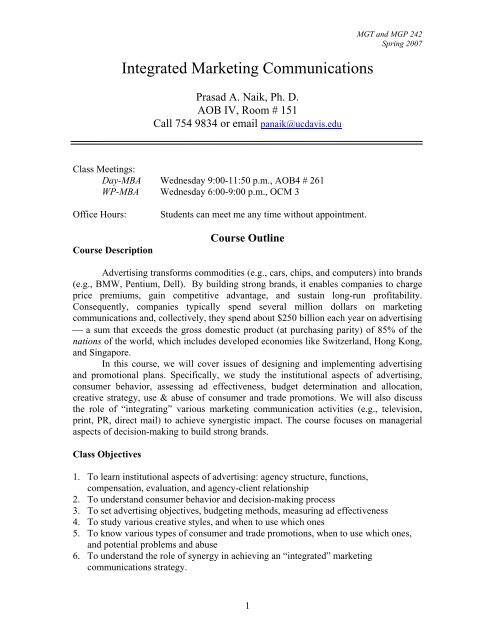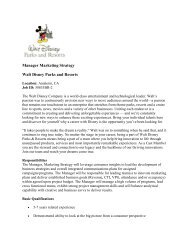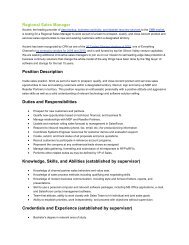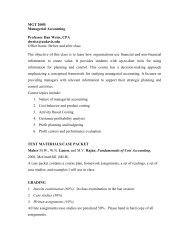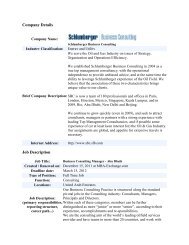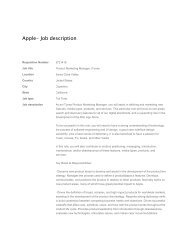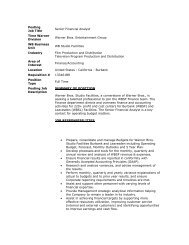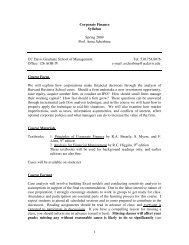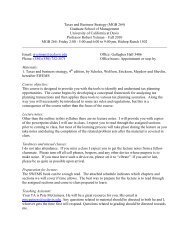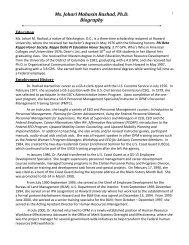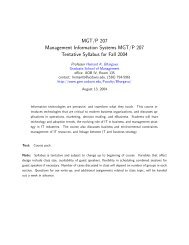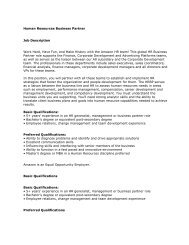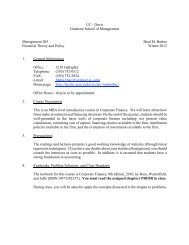Integrated Marketing Communications - Students
Integrated Marketing Communications - Students
Integrated Marketing Communications - Students
You also want an ePaper? Increase the reach of your titles
YUMPU automatically turns print PDFs into web optimized ePapers that Google loves.
<strong>Integrated</strong> <strong>Marketing</strong> <strong>Communications</strong><br />
Prasad A. Naik, Ph. D.<br />
AOB IV, Room # 151<br />
Call 754 9834 or email panaik@ucdavis.edu<br />
MGT and MGP 242<br />
Spring 2007<br />
Class Meetings:<br />
Day-MBA Wednesday 9:00-11:50 p.m., AOB4 # 261<br />
WP-MBA Wednesday 6:00-9:00 p.m., OCM 3<br />
Office Hours:<br />
Course Description<br />
<strong>Students</strong> can meet me any time without appointment.<br />
Course Outline<br />
Advertising transforms commodities (e.g., cars, chips, and computers) into brands<br />
(e.g., BMW, Pentium, Dell). By building strong brands, it enables companies to charge<br />
price premiums, gain competitive advantage, and sustain long-run profitability.<br />
Consequently, companies typically spend several million dollars on marketing<br />
communications and, collectively, they spend about $250 billion each year on advertising<br />
⎯ a sum that exceeds the gross domestic product (at purchasing parity) of 85% of the<br />
nations of the world, which includes developed economies like Switzerland, Hong Kong,<br />
and Singapore.<br />
In this course, we will cover issues of designing and implementing advertising<br />
and promotional plans. Specifically, we study the institutional aspects of advertising,<br />
consumer behavior, assessing ad effectiveness, budget determination and allocation,<br />
creative strategy, use & abuse of consumer and trade promotions. We will also discuss<br />
the role of “integrating” various marketing communication activities (e.g., television,<br />
print, PR, direct mail) to achieve synergistic impact. The course focuses on managerial<br />
aspects of decision-making to build strong brands.<br />
Class Objectives<br />
1. To learn institutional aspects of advertising: agency structure, functions,<br />
compensation, evaluation, and agency-client relationship<br />
2. To understand consumer behavior and decision-making process<br />
3. To set advertising objectives, budgeting methods, measuring ad effectiveness<br />
4. To study various creative styles, and when to use which ones<br />
5. To know various types of consumer and trade promotions, when to use which ones,<br />
and potential problems and abuse<br />
6. To understand the role of synergy in achieving an “integrated” marketing<br />
communications strategy.<br />
1
MGT and MGP 242<br />
Spring 2007<br />
Class Administration<br />
Classes consist of lectures, cases, articles, and projects. Lectures provide concepts<br />
and principles of advertising, promotions, direct marketing, and IMC. Cases are used to<br />
develop the skills in problem-solving. <strong>Students</strong> are expected to carefully read and<br />
thoroughly analyze the assigned case, consider information available at the time of the<br />
case event, identify the relevant issues, generate alternatives, and recommend actions.<br />
Articles, written by leading scholars in the specific topics, furnish literature reviews or<br />
discuss the state-of-the-art issues.<br />
Project. A small group of five or fewer students will form teams, and each team<br />
will identify a topic of interest related to advertising, promotion, or database marketing.<br />
For example, what characteristics of commercials such as humor, music, or computer<br />
animation make them memorable What are the current approaches to measure<br />
effectiveness of Internet advertising To not restrict your creativity in selecting topics, I<br />
do not provide further examples here. The teams will do research on their chosen topic,<br />
and thus provide information, fresh perspectives, and/or new insights. A final report and<br />
its presentation will summarize your findings.<br />
Grading<br />
25 points Class participation and quality of discussions<br />
25 points Mid-term Exam<br />
25 points Final Exam<br />
25 points Project Presentation and Report<br />
Optional Texts (i.e., buy it if you want to):<br />
• Advertising and Promotion: An IMC Perspective, 7 th edition, by Belch and Belch.<br />
• Effective Advertising, by Gerard Tellis, Sage Publications, 2004.<br />
Course Packet: Selected reading materials and cases as follows:<br />
• Mountain Dew Case<br />
• “Optimal <strong>Marketing</strong>,” by Corstjens and Merrihue, HBR article<br />
• “Three Faces of Consumer Promotions,” by Raghubir, Inman, Grande, California<br />
Management Review, 2004.<br />
• “How Advertising Practitioners View Ethics,” by Drumwright and Patrick<br />
Murphy, Journal of Advertising, Vol. 33, No. 2, pp. 7-24.<br />
• “Science of Persuasion,” by Robert Cialdini, Scientific American, 2003, p. 70-77.<br />
• “<strong>Integrated</strong> <strong>Marketing</strong> <strong>Communications</strong>,” Harvard Business School.<br />
• “Sales Promotion,” by Scott Neslin, Handbook of <strong>Marketing</strong>.<br />
• “<strong>Integrated</strong> <strong>Marketing</strong> <strong>Communications</strong>: Provenance, Practice and Principles,” by<br />
Prasad Naik, Handbook of Advertising, forthcoming 2007.<br />
• RFID at the Metro Group, HBS 9-606-053, 2005.<br />
2


